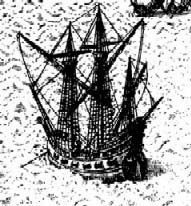New Course Follows Musical Trail of Jamestown 1607
 May 2007 marks the 400th anniversary of the landing at Jamestowne
and the establishment of the first permanent English settlement in the
New World. With the landing site just a few miles down the road,
students at W&M will be following the musical trails that lead to
and from that event.
May 2007 marks the 400th anniversary of the landing at Jamestowne
and the establishment of the first permanent English settlement in the
New World. With the landing site just a few miles down the road,
students at W&M will be following the musical trails that lead to
and from that event.
On May 13, 1607 three ships anchored at what is now Jamestown Island, twenty miles up the Chesapeake Bay in southeastern Virginia. The hundred-odd men who disembarked began building a fort the next day; their efforts eventually--after many dangers, toils, and snares--led to the founding of the first permanent English settlement in the New World.
The original fort was long thought lost, washed away in the James River. But beginning a dozen years ago, excavations led by William Kelso made an astounding find: remains of all but one edge of the fort area were still there, and the ground in the entire area was thickly-strewn with artifacts. Over one million items, from pottery shards to halbards, coins to cutlasses, and even a few entire skeletons, have been painstakingly dug out of the ground at the fort site.
Among those artifacts are half a dozen of musical interest: a trumpet mouthpiece, a jaw harp, a tambourine cymbal, a bell-shaped object, and a few small items that may be related to reed instruments.
Students from The College of William & Mary will be making use of the college's ideal location this semester to trace the musical trails leading to and from this historic site. In a new course called "Music in 1607," led by Ruth van Baak Griffioen, students will visit the Jamestowne dig site (conveniently located just seven miles down the road from the college) and the new museum, the Archaearium, which opened just last year to display and interpret the archaeological finds.
In addition, the class will visit the collection of musical prints and manuscripts owned by Colonial Williamsburg (even more conveniently located in walking distance of the college) and hear live demonstrations by area musicians who specialize professionally in transforming the often-incomplete musical instructions from parchment to reality.
Again drawing on the rich musical resources of the Williamsburg community, the class will be treated to a "Musical Instrument Day," during which a dozen local musicians who have mastered a variety of 17th-century instruments will give hands-on demonstrations of the recorder, renaissance flute, crumhorn, doucaine, rauschpfeife, hurdy-gurdy, lute, cittern, renaissance guitar, cornetto, sackbut, viola da gamba, vielle, harpsichord and chamber organ.
Because of the upcoming 400th anniversary commemoration of the 1607 landing, the students will also have a unique opportunity to sit in on rehearsals and performances of several area early music ensembles as they prepare for concerts featuring seventeenth-century music and dance. These include the Virginia Academy of Historical Dance presentations on February 23-24, the W&M Early Music Ensemble (April 15), and the W&M Music department's own faculty early music ensemble, The Wren Masters (April 21). For more information on those concerts, visit the department's Events Calendar.
The course "Music in 1607" (Music 365, section 4) will meet Fridays from noon to 2:45 during the spring semester 2007. For more information, contact Dr. Griffioen at [[rvbgri]]. Webpage: http://www.physics.wm.edu/~griff/ruth/home.html.
 Skip to main content
Skip to main content
